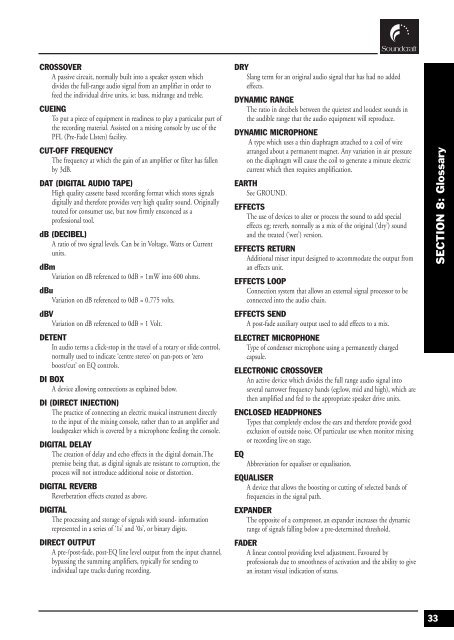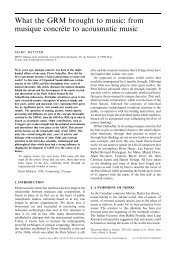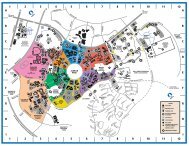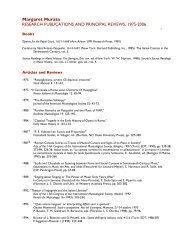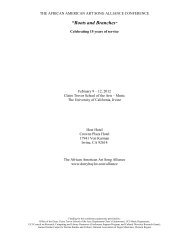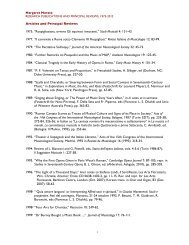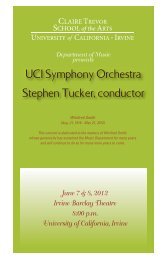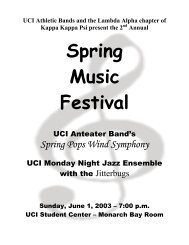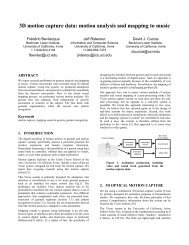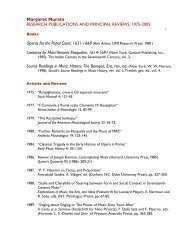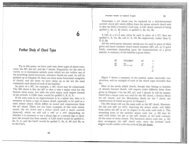Soundcraft Guide to Mixing - Music
Soundcraft Guide to Mixing - Music
Soundcraft Guide to Mixing - Music
- No tags were found...
You also want an ePaper? Increase the reach of your titles
YUMPU automatically turns print PDFs into web optimized ePapers that Google loves.
CROSSOVERA passive circuit, normally built in<strong>to</strong> a speaker system whichdivides the full-range audio signal from an amplifier in order <strong>to</strong>feed the individual drive units, ie: bass, midrange and treble.CUEINGTo put a piece of equipment in readiness <strong>to</strong> play a particular part ofthe recording material. Assisted on a mixing console by use of thePFL (Pre-Fade LIsten) facility.CUT-OFF FREQUENCYThe frequency at which the gain of an amplifier or filter has fallenby 3dB.DAT (DIGITAL AUDIO TAPE)High quality cassette based recording format which s<strong>to</strong>res signalsdigitally and therefore provides very high quality sound. Originally<strong>to</strong>uted for consumer use, but now firmly ensconced as aprofessional <strong>to</strong>ol.dB (DECIBEL)A ratio of two signal levels. Can be in Voltage, Watts or Currentunits.dBmVariation on dB referenced <strong>to</strong> 0dB = 1mW in<strong>to</strong> 600 ohms.dBuVariation on dB referenced <strong>to</strong> 0dB = 0.775 volts.dBVVariation on dB referenced <strong>to</strong> 0dB = 1 Volt.DETENTIn audio terms a click-s<strong>to</strong>p in the travel of a rotary or slide control,normally used <strong>to</strong> indicate ‘centre stereo’ on pan-pots or ‘zeroboost/cut’ on EQ controls.DI BOXA device allowing connections as explained below.DI (DIRECT INJECTION)The practice of connecting an electric musical instrument directly<strong>to</strong> the input of the mixing console, rather than <strong>to</strong> an amplifier andloudspeaker which is covered by a microphone feeding the console.DIGITAL DELAYThe creation of delay and echo effects in the digital domain.Thepremise being that, as digital signals are resistant <strong>to</strong> corruption, theprocess will not introduce additional noise or dis<strong>to</strong>rtion.DIGITAL REVERBReverberation effects created as above.DIGITALThe processing and s<strong>to</strong>rage of signals with sound- informationrepresented in a series of ‘1s’ and ‘0s’, or binary digits.DIRECT OUTPUTA pre-/post-fade, post-EQ line level output from the input channel,bypassing the summing amplifiers, typically for sending <strong>to</strong>individual tape tracks during recording.DRYSlang term for an original audio signal that has had no addedeffects.DYNAMIC RANGEThe ratio in decibels between the quietest and loudest sounds inthe audible range that the audio equipment will reproduce.DYNAMIC MICROPHONEA type which uses a thin diaphragm attached <strong>to</strong> a coil of wirearranged about a permanent magnet. Any variation in air pressureon the diaphragm will cause the coil <strong>to</strong> generate a minute electriccurrent which then requires amplification.EARTHSee GROUND.EFFECTSThe use of devices <strong>to</strong> alter or process the sound <strong>to</strong> add specialeffects eg; reverb, normally as a mix of the original (‘dry’) soundand the treated (‘wet’) version.EFFECTS RETURNAdditional mixer input designed <strong>to</strong> accommodate the output froman effects unit.EFFECTS LOOPConnection system that allows an external signal processor <strong>to</strong> beconnected in<strong>to</strong> the audio chain.EFFECTS SENDA post-fade auxiliary output used <strong>to</strong> add effects <strong>to</strong> a mix.ELECTRET MICROPHONEType of condenser microphone using a permanently chargedcapsule.ELECTRONIC CROSSOVERAn active device which divides the full range audio signal in<strong>to</strong>several narrower frequency bands (eg:low, mid and high), which arethen amplified and fed <strong>to</strong> the appropriate speaker drive units.ENCLOSED HEADPHONESTypes that completely enclose the ears and therefore provide goodexclusion of outside noise. Of particular use when moni<strong>to</strong>r mixingor recording live on stage.EQAbbreviation for equaliser or equalisation.EQUALISERA device that allows the boosting or cutting of selected bands offrequencies in the signal path.EXPANDERThe opposite of a compressor, an expander increases the dynamicrange of signals falling below a pre-determined threshold.FADERA linear control providing level adjustment. Favoured byprofessionals due <strong>to</strong> smoothness of activation and the ability <strong>to</strong> givean instant visual indication of status.SECTION 8: Glossary33


